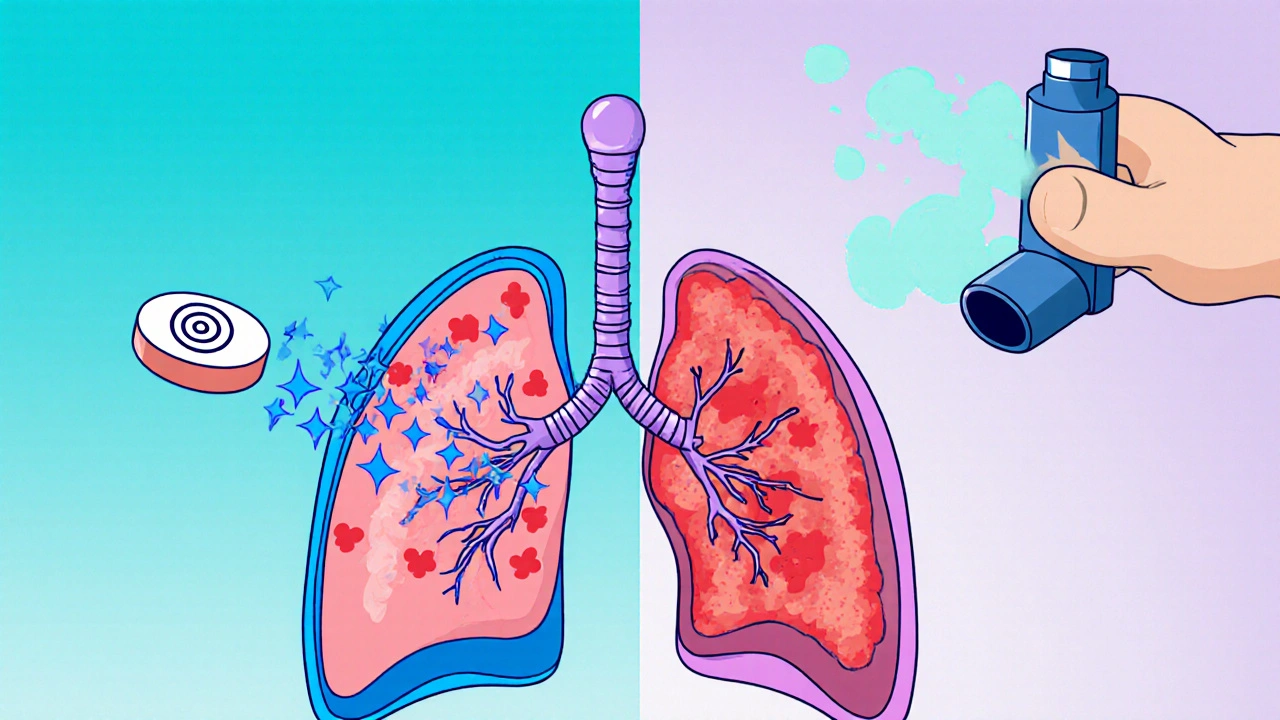COPD Treatment Comparison Tool
Treatment Comparison Tool
Select your COPD characteristics to see which treatment options might be most suitable for your situation.
Treatment Recommendations
Daliresp (Roflumilast)
Oral PDE4 inhibitor
Best for: Patients with frequent exacerbations and severe COPD
Key benefit: Reduces exacerbation frequency by approximately 15%
Typical cost: £80-£100/month (with manufacturer discounts)
Tiotropium (LAMA)
Inhaled long-acting muscarinic antagonist
Best for: Patients with moderate COPD and bronchodilation needs
Key benefit: Improves FEV1 by 120 mL and reduces exacerbations by 20-30%
Typical cost: £20-£30/month (generic)
Umeclidinium (LAMA)
Inhaled long-acting muscarinic antagonist
Best for: Patients with moderate to severe COPD
Key benefit: Improves FEV1 by 110 mL and reduces exacerbations by 20-30%
Typical cost: £25-£35/month (generic)
Budesonide/Formoterol (ICS/LABA)
Inhaled corticosteroid + LABA combination
Best for: Patients with eosinophilic inflammation
Key benefit: Improves FEV1 by 180 mL and reduces exacerbations by 25-35%
Typical cost: £20-£45/month (generic to brand)
Recommendation Summary
Always discuss treatment options with your healthcare provider to determine the best choice for your individual needs.
Key Takeaways
- Daliresp is the only oral PDE4 inhibitor approved for COPD maintenance.
- It targets inflammation, whereas most alternatives are bronchodilators.
- Clinical trials show modest FEV1 improvement but a higher rate of gastrointestinal side effects.
- Cost and insurance coverage vary widely; generic alternatives may be cheaper but less effective for certain patients.
- Choosing the right option depends on disease severity, comorbidities, and patient preference.
When treating Daliresp is a once‑daily oral phosphodiesterase‑4 (PDE4) inhibitor containing the active ingredient roflumilast, the big question is whether it outperforms other COPD options. You might have heard about inhaled bronchodilators, corticosteroids, or even other oral agents and wonder which one fits your lifestyle. This guide breaks down the science, efficacy, safety, and practical considerations so you can compare Daliresp with real‑world alternatives without getting lost in medical jargon.
What Is Daliresp (Roflumilast)?
Roflumilast is the active molecule inside Daliresp, classified as a phosphodiesterase‑4 (PDE4) inhibitor. By blocking the PDE4 enzyme, it reduces inflammatory cytokine release in the lungs, which helps slow down exacerbations for patients with severe COPD and a history of frequent flare‑ups.
The standard dose is 500 µg taken orally once a day, usually with food to minimize stomach upset. Because it works systemically, it can reach airway cells that inhaled drugs might miss, but that also means it can affect other organs, leading to side effects like nausea, weight loss, and mood changes.
How Does Daliresp Differ From Inhaled Therapies?
Most COPD maintenance drugs are inhaled, delivering medication directly to the airways. The two biggest inhaled classes are:
- Long‑acting muscarinic antagonists (LAMA) - examples include tiotropium and umeclidinium.
- Inhaled corticosteroids (ICS) - often combined with long‑acting beta‑agonists (LABA) like budesonide/formoterol.
These inhaled options mainly act as bronchodilators (LAMA) or anti‑inflammatory agents (ICS/LABA). Daliresp, on the other hand, targets inflammation via a different pathway (PDE4 inhibition) and is taken orally, which can be a game‑changer for patients who struggle with inhaler technique.
Clinical Effectiveness: Numbers That Matter
In the pivotal 52‑week trials, Daliresp reduced the rate of moderate‑to‑severe COPD exacerbations by about 15 % compared with placebo. The average increase in forced expiratory volume in one second (FEV1) was modest-around 30 mL-yet the real benefit lay in fewer hospital visits.
By contrast, LAMA agents such as tiotropium typically deliver a 100‑150 mL FEV1 boost and cut exacerbation risk by 20‑30 %. The combination budesonide/formoterol adds anti‑inflammatory action and can improve lung function by up to 200 mL, especially in patients with eosinophilic inflammation.
So, if raw FEV1 numbers are your primary concern, inhaled bronchodilators win. If you’re focused on reducing flare‑ups in a patient who already uses optimal inhalers, Daliresp can provide that extra edge.

Side‑Effect Profile: What to Watch For
Every medication comes with trade‑offs. Here’s a quick glance at the most common adverse events:
| Drug | GI Issues | Weight Change | Mood Effects | Serious Risks |
|---|---|---|---|---|
| Daliresp (Roflumilast) | Nausea, Diarrhea (≈ 30 %) | Weight loss (≈ 5 %) | Depression, Anxiety (≈ 2 %) | Rare: severe psychiatric events |
| Tiotropium | Rare | Neutral | None | Possible urinary retention |
| Umeclidinium | Rare | Neutral | None | Increased risk of cardiovascular events in high‑risk groups |
| Budesonide/Formoterol | Oral thrush, Hoarseness | Possible weight gain | None | Higher pneumonia risk in severe COPD |
Given the higher incidence of gastrointestinal upset and mood changes, clinicians usually start Daliresp at a lower dose (250 µg) and titrate up if tolerated.
Cost and Accessibility
Price varies by country and insurance coverage. In the UK, Daliresp is listed on the NHS for patients meeting strict criteria (severe COPD, ≥2 exacerbations per year despite optimal inhaler therapy). The list price hovers around £80‑£100 per month, whereas generic LAMA inhalers can be as low as £20‑£30.
For patients without NHS coverage, discount programs from the manufacturer may reduce out‑of‑pocket costs. Always check local formularies and talk to a pharmacist about possible coupons.
When to Choose Daliresp Over Alternatives
Here are four clinical scenarios that often tip the scales toward Daliresp:
- Frequent exacerbations despite optimal inhaler regimen. Adding an oral anti‑inflammatory can break the cycle.
- Inhaler technique problems. Patients with arthritis or severe dyspnea may struggle with hand‑held devices.
- High eosinophil count but contraindications to high‑dose inhaled steroids. Daliresp provides inflammation control without steroid‑related side effects.
- Preference for once‑daily oral dosing. Improves adherence for some patients.
If none of these apply, a LAMA or an ICS/LABA combo will likely offer greater lung‑function gains with fewer systemic side effects.
Comparison Table: Daliresp vs Common Alternatives
| Attribute | Daliresp (Roflumilast) | Tiotropium (LAMA) | Umeclidinium (LAMA) | Budesonide/Formoterol (ICS/LABA) |
|---|---|---|---|---|
| Class | Oral PDE4 inhibitor | Inhaled LAMA | Inhaled LAMA | Inhaled corticosteroid + LABA |
| Dose | 500 µg PO daily | 18 µg inhalation daily | 62.5 µg inhalation daily | 200 µg/6 µg inhalation twice daily |
| Primary benefit | Reduces exacerbation frequency | Bronchodilation, improves FEV1 | Bronchodilation, improves FEV1 | Anti‑inflammation + bronchodilation |
| Avg. FEV1 change | +30 mL | +120 mL | +110 mL | +180 mL |
| Exacerbation reduction | ≈15 % | ≈20‑30 % | ≈20‑30 % | ≈25‑35 % |
| Common side effects | Nausea, weight loss, mood changes | Dry mouth, urinary retention | Dry mouth, rare cardiovascular events | Oral thrush, hoarseness, pneumonia risk |
| Cost (UK, monthly) | £80‑£100 (manufacturer discount possible) | £20‑£30 (generic) | £25‑£35 (generic) | £35‑£45 (brand) / £20‑£30 (generic) |
| Typical candidates | Severe COPD, ≥2 exacerbations/year, inhaler‑resistant | All COPD stages, especially GOLD 2‑3 | All COPD stages, especially GOLD 2‑3 | Patients with eosinophilic phenotype or steroid‑responsive disease |
Practical Tips for Switching to Daliresp
- Assess baseline weight. Patients <5 kg under ideal body weight may need closer monitoring.
- Screen for depression. Use PHQ‑9 before starting; revisit after 4 weeks.
- Start low, go slow. Some clinicians begin at 250 µg for the first two weeks to improve tolerance.
- Coordinate with inhaler regimen. Daliresp is an add‑on, not a replacement for bronchodilators.
- Monitor lung function. Repeat spirometry after 12 weeks to gauge real‑world benefit.
Frequently Asked Questions
Can Daliresp be used with other COPD inhalers?
Yes. Daliresp is intended as an add‑on therapy. It works best when patients are already on a stable inhaled regimen, such as a LAMA or an ICS/LABA combination.
What is the most common side effect?
Gastro‑intestinal upset, especially nausea and diarrhoea, occurs in about one‑third of users. Taking the tablet with food often eases the problem.
Is Daliresp safe for patients with liver disease?
Roflumilast is metabolised by the liver. Dose reduction is recommended for moderate hepatic impairment, and it is contraindicated in severe liver disease.
How long does it take to see a reduction in exacerbations?
Clinical studies show a noticeable decline after 8‑12 weeks, but the full benefit can continue to improve for up to a year of consistent use.
Are there any drug interactions I should be aware of?
Roflumilast is a CYP3A4 substrate. Strong inducers (e.g., rifampicin) can lower its levels, while strong inhibitors (e.g., ketoconazole) may increase exposure and side‑effects.
Bottom Line
If you’ve exhausted inhaler optimisation and still suffer from flare‑ups, Daliresp offers a worthwhile oral alternative that tackles the inflammatory component of COPD. It doesn’t provide the same bronchodilation boost as LAMA or ICS/LABA combos, so it should complement-not replace-those therapies. Weigh the modest lung‑function gains against the higher risk of GI upset and mood changes, and factor in your budget or insurance coverage. Talk to your pulmonologist or pharmacist; together you can decide whether adding a PDE4 inhibitor fits your personalized COPD plan.


9 Comments
Doreen Collins
Great overview of Daliresp and how it fits into the COPD toolbox. I appreciate the clear breakdown of when an oral PDE4 inhibitor makes sense. For patients who struggle with inhaler technique, an oral option can be a game‑changer. It's also helpful to see the side‑effect profile laid out side by side. Keep the practical tips coming!
Casey Morris
Ah, the intricate tapestry of pharmacologic nuance,-indeed, one must weigh efficacy against tolerability,-especially when considering systemic agents; the data presented here is, without doubt, a valuable compass for clinicians,-and for patients alike.
Teya Arisa
Dear Reader, I commend the thoroughness of this comparative analysis; the inclusion of cost considerations alongside clinical efficacy reflects a commendable holistic approach. Moreover, the elucidation of patient selection criteria aligns with evidence‑based practice. Please accept my gratitude for such meticulous work. 😊👍
Kester Strahan
From a pathophysiological standpoint, the PDE4 inhibition mechanism offers a distinct anti‑inflammatory cascade, which is particularly relevant in eosinophil‑mediated phenotypes. However, the pharmacokinetic profile-steady‑state concentration achieved after ~2 weeks-necessitates adherence vigilance. Also, the real‑world adherence rates for oral vs inhaled modalities differ markedly, often due to device‑related user errors, which you kinda nailed in the article.
Lindy Hadebe
This article overstates the benefits of Daliresp; the data are underwhelming.
Ekeh Lynda
Roflumilast works by inhibiting the phosphodiesterase 4 enzyme in immune cells. This reduces the release of pro inflammatory cytokines. The drug is taken once daily with food. The recommended dose is five hundred micrograms. Clinical trials showed a fifteen percent reduction in exacerbations. The improvement in forced expiratory volume was modest. Patients often report nausea and diarrhoea. Weight loss can be observed in a subset of users. Mood changes have been documented in a small percentage of the population. The gastrointestinal side effects are the most common reason for discontinuation. Cost considerations vary across health systems. In the United Kingdom the medication is listed on the national health service for severe cases. In the United States insurance coverage can be unpredictable. Some clinicians start with a lower dose to improve tolerability. Titration to the full dose should be guided by patient response. Overall the drug adds an oral option to the COPD armamentarium.
junior garcia
Wow, that was a solid rundown! I can see how Daliresp could fit into a treatment plan when inhalers are a hurdle. Let’s hope patients get the support they need to stay on it.
Jordan Levine
Listen, if you think a fancy over‑the‑top paragraph will convince anyone, you’re missing the point-Daliresp is just another pill with a hefty price tag! 💢🇺🇸
Mary Mundane
Another overpriced drug with questionable payoff.